-
In Kashmir, No Refuge for Wildlife
›February 20, 2009 // By Will Rogers “Human-animal conflicts have assumed alarming proportions in the region,” Asghar Inayati, a regional wildlife warden in Kashmir, recently told Inter Press Service (IPS) News. Since India and Pakistan gained independence in 1949, both sides have fought for control of the territory. Not only has the decades-long conflict claimed 100,000 lives (by some estimates), it has also displaced animals from their natural habitats, sparking violent encounters with local people and threatening many species’ survival.
“Human-animal conflicts have assumed alarming proportions in the region,” Asghar Inayati, a regional wildlife warden in Kashmir, recently told Inter Press Service (IPS) News. Since India and Pakistan gained independence in 1949, both sides have fought for control of the territory. Not only has the decades-long conflict claimed 100,000 lives (by some estimates), it has also displaced animals from their natural habitats, sparking violent encounters with local people and threatening many species’ survival. -
For Many, Sea-Level Rise Already an Issue
›February 11, 2009 // By Will Rogers Global sea level is projected to rise between 7 and 23 inches by 2100, according to the Intergovernmental Panel on Climate Change (IPCC). Recent melting of the Antarctic ice sheet has prompted geophysicists at the University of Toronto and Oregon State University to warn that global sea level could rise 25 percent beyond the IPCC projections. These catastrophic long-term predictions tend to overshadow the potentially devastating near-term impacts of global sea-level rise that have, in some places, already begun.
Global sea level is projected to rise between 7 and 23 inches by 2100, according to the Intergovernmental Panel on Climate Change (IPCC). Recent melting of the Antarctic ice sheet has prompted geophysicists at the University of Toronto and Oregon State University to warn that global sea level could rise 25 percent beyond the IPCC projections. These catastrophic long-term predictions tend to overshadow the potentially devastating near-term impacts of global sea-level rise that have, in some places, already begun. -
This Just In: Panel Ponders Perils to Planetary Reporting
›February 6, 2009 // By Peter Dykstra I’m a little over halfway through my brief stay here at the Wilson Center. This fellowship was made possible by CNN: They laid me off, along with my entire science, tech, and environment news team, in December.
I’m a little over halfway through my brief stay here at the Wilson Center. This fellowship was made possible by CNN: They laid me off, along with my entire science, tech, and environment news team, in December.
We’re not alone: Many reporters and producers like us have found new meaning to the phrase “working journalist.” Non-working journalists now represent a significant piece of the pie.
Rightly or wrongly, many top news executives view beats like science and environment as peripheral to the journalistic mission, or at least to the business plan, of their organizations. Attention to these topics in the general media has a hard time competing with things viewed as more central, whether it’s politics or Paris Hilton.
On Thursday, February 12, in the Wilson Center’s Flom Auditorium, we’ll celebrate Lincoln’s 200th birthday by discussing how to make sure science and environment reporting doesn’t perish from this earth.
Two of the most accomplished science and environment reporters in Washington will join us: Seth Borenstein of the Associated Press and Elizabeth Shogren (not yet confirmed) of NPR. Seth and Elizabeth were among the best chroniclers of the environmental controversies that marked the Bush era, and are closely tracking the promised “change” that may (or may not) be underway in the Obama administration. Both are alumni of news organizations that have recently seen traumatic change: Seth as a correspondent for the Washington Bureau of Knight-Ridder, and Elizabeth for the Los Angeles Times.
Also on the agenda is the future of journalism itself: Newspapers as we now know them may be terminally ill; TV broadcast news as we know it may be five or 10 years behind. Panelist Jan Schaffer, director of J-Lab at American University, will bring her expertise on new- and community-based media. J-Lab is a journalism R&D; center, focusing on providing both guidance and financial support to citizen journalism projects. Jan, a former Philadelphia Inquirer editor and Pulitzer Prize winner, will help us see the way to what journalism will look like 10 and 20 years from now.
Space is limited, so RSVP to the Wilson Center’s Environmental Change and Security Program soon. If you can’t make it to D.C., you can watch the webcast live.
Photo: Peter Dykstra. Courtesy of Dave Hawxhurst and the Woodrow Wilson Center.
Peter Dykstra is the former executive producer for science, technology, environment, and weather at CNN, and a current public policy scholar at the Woodrow Wilson Center. He also writes for www.mnn.com. -
Developed World’s Dominance Declines with Age, Say Demographers
›February 5, 2009 // By Will Rogers “The whole world is aging, and the developed countries are leading the way,” said Neil Howe of the Center for Strategic and International Studies (CSIS) at a January 27, 2009, Wilson Center discussion of his latest report, The Graying of the Great Powers: Demography and Geopolitics in the 21st Century. Demography is as close as social science comes to predicting the future, Howe explained, presenting the geopolitical consequences of demographic trends over the next 50 years. Howe and co-author Richard Jackson, also of CSIS, were joined by Jennifer Sciubba of Rhodes College, who urged them and other demographers to explore how population trends interact with additional variables, such as environmental degradation, economic recession, and conflict.
“The whole world is aging, and the developed countries are leading the way,” said Neil Howe of the Center for Strategic and International Studies (CSIS) at a January 27, 2009, Wilson Center discussion of his latest report, The Graying of the Great Powers: Demography and Geopolitics in the 21st Century. Demography is as close as social science comes to predicting the future, Howe explained, presenting the geopolitical consequences of demographic trends over the next 50 years. Howe and co-author Richard Jackson, also of CSIS, were joined by Jennifer Sciubba of Rhodes College, who urged them and other demographers to explore how population trends interact with additional variables, such as environmental degradation, economic recession, and conflict.
Danger: Demographic Decline Approaching
“Populations in most developed countries will not only age, but stagnate or decline,” due to falling fertility and rising longevity, said Howe. Without “sizable immigration,” he warned, the populations of countries like the United States, France, Great Britain, Canada, Germany, and Japan will decline. As developed countries’ populations shrink, they will lose military might, savings and investment, entrepreneurship, and cultural influence. “Voltaire once said that God is on the side of biggest battalions,” Howe reminded the audience.
Developing Toward Greater Peace Jackson explained that the developing world is in the midst of the “demographic transition”—the drops in mortality and fertility that generally accompany economic and social development. Since 1970, the developing world’s overall fertility rate has declined from 5.1 to 2.9 children per woman, and its overall population growth rate has dropped from 2.2 percent to 1.3 percent per year, according to Jackson. Additionally, the median age has risen from 20 to 26 years old, “a cause for hope and optimism about the future,” Jackson argued, as countries with more balanced population age structures tend to be more democratic, prosperous, and peaceful than countries with extremely young ones.
Jackson explained that the developing world is in the midst of the “demographic transition”—the drops in mortality and fertility that generally accompany economic and social development. Since 1970, the developing world’s overall fertility rate has declined from 5.1 to 2.9 children per woman, and its overall population growth rate has dropped from 2.2 percent to 1.3 percent per year, according to Jackson. Additionally, the median age has risen from 20 to 26 years old, “a cause for hope and optimism about the future,” Jackson argued, as countries with more balanced population age structures tend to be more democratic, prosperous, and peaceful than countries with extremely young ones.
But despite the long-term possibility of a world transitioning toward greater peace and prosperity, the developing world will still experience near-term shocks. The timing and pace of the demographic transition varies widely by country and region, with some countries transitioning too fast or too far, said Jackson. These trends could push developing countries toward social collapse by acting “as a kind of multiplier on all the stresses of development,” explained Jackson—for instance, causing China “to lurch even more toward neo-authoritarianism.”
Crisis of the 2020s
Global demographic trends will converge in the 2020s to make that decade “very challenging,” said Howe. The developed world will undergo hyper-aging, population decline, and flattening GDP growth, along with rising pension and health care costs, Jackson noted. The Muslim world will experience a decade of temporary youth bulges, as the large generation that was born between 1990 and 2000 has children. The populations of Russia and Eastern Europe will implode, and Russia’s geopolitical strength and influence will wane. Meanwhile, China will experience a decade of “premature aging”; due to its one-child policy, it will become “gray” before it achieves the per capita GDP of most aging countries.
Demography and Public Policy Sciubba praised the report’s comprehensive, policy-friendly approach to demography, but urged the authors to remain true to the nuances of their topic, even in their conclusions and recommendations. “Policymakers like to know what we don’t know and what we do know. And with population aging and national security, often there’s a lot more of what we don’t know than what we do know,” she said. “Going into the future, we need more of an emphasis on places where policymakers can make a difference,” said Sciubba. “Opportunities matter just as much as challenges.”
Sciubba praised the report’s comprehensive, policy-friendly approach to demography, but urged the authors to remain true to the nuances of their topic, even in their conclusions and recommendations. “Policymakers like to know what we don’t know and what we do know. And with population aging and national security, often there’s a lot more of what we don’t know than what we do know,” she said. “Going into the future, we need more of an emphasis on places where policymakers can make a difference,” said Sciubba. “Opportunities matter just as much as challenges.”Photos: Neil Howe, Richard Jackson, and Jennifer Dabbs Sciubba. Courtesy of Dave Hawxhurst and the Wilson Center.
-
Human Health Dependent on Biodiversity, Argue Scientists
›January 29, 2009 // By Rachel Weisshaar “There’s such a fundamental misunderstanding that most people have about the environment—that it exists outside of us,” said Harvard Medical School’s Eric Chivian at the January 14, 2009, launch of Sustaining Life: How Human Health Depends on Biodiversity, which he co-edited. This disconnect “is really at the heart of the global environmental crisis, and it’s the reason we wrote this book.” Chivian was joined by the Natural Capital Project’s Michael Wright and the Heinz Center’s Thomas Lovejoy, who called Sustaining Life “a remarkable achievement,” for a discussion of the myriad ways in which biodiversity benefits human health—and how its loss endangers us.
“There’s such a fundamental misunderstanding that most people have about the environment—that it exists outside of us,” said Harvard Medical School’s Eric Chivian at the January 14, 2009, launch of Sustaining Life: How Human Health Depends on Biodiversity, which he co-edited. This disconnect “is really at the heart of the global environmental crisis, and it’s the reason we wrote this book.” Chivian was joined by the Natural Capital Project’s Michael Wright and the Heinz Center’s Thomas Lovejoy, who called Sustaining Life “a remarkable achievement,” for a discussion of the myriad ways in which biodiversity benefits human health—and how its loss endangers us.
Proof Positive: Biodiversity Supports Health
The most exotic—and unlikely—species can yield valuable discoveries, Lovejoy explained. For example, slime molds on the banks of the Zambezi River repel their enemies with chemicals that can treat cancers resistant to Taxol, one of the main chemotherapy drugs—which is itself derived from the needles and bark of the Pacific yew tree. Chivian offered another remarkable example: The best new pain medication, which is 1,000 times more powerful than morphine, is derived from the toxins of marine cone snails.
Of Polar Bears and Parasites
Polar bears—which new research suggests are likely to be extinct in the wild by 2100 due to the melting of the Arctic ice sheet—may help cure several devastating diseases. Polar bears “den,” or near-hibernate, for five to nine months of each year, yet substances in their blood prevent them from losing bone mass during that time. “Osteoporosis is an enormous public health problem; it kills some 70,000 people in the United States every year, costs the U.S. economy $18 billion dollars a year,” explained Chivian.
When they den, polar bears go for months without eating, drinking, defecating, or urinating. Studying this phenomenon may provide humans with alternatives to dialysis or kidney transplants. Finally, while polar bears are extremely obese, they do not develop Type II diabetes. In contrast, 16 million Americans—6 percent of the population—have obesity-related Type II diabetes, costing the United States $91 billion a year. “Again, polar bears may hold the secret for treating this very difficult and lethal disease,” said Chivian.
Not only can certain species help us treat human diseases, but the loss of biodiversity can increase the prevalence of others. For instance, Lyme disease is more common in degraded environments with low vertebrate diversity. In these environments, the disease spreads more quickly because the white-footed mouse—the best vector for Lyme disease—has fewer predators and competitors for food.
Better Safe Than Sorry
By providing dozens of concrete examples of how we depend on and benefit from the environment, Sustaining Life is “a wonderful rebuttal to people who call conservationists treehuggers,” said Wright. Yet he reminded the audience that the path from species to valuable product is serendipitous and unpredictable. Therefore, he argued, we should endeavor to protect all species in order to save those that may most benefit human health.
Chivian, who shared a Nobel Peace Prize for his work on the medical dimensions of nuclear war, argued that it is difficult for the public to grasp the threats posed by climate change: “The level of complexity and abstraction is really an order of magnitude—or many times more than that—greater than it is about nuclear weapons…and therefore, it’s even more essential for physicians and public health professionals to describe and discuss these global environmental changes in human-health terms.”
Photo: Eric Chivian of Harvard Medical School. Courtesy of the Wilson Center and Dave Hawxhurst. -
Reading Radar– A Weekly Roundup
›January 23, 2009 // By Wilson Center Staff“As long as we continue to subsidize Gaza’s extreme demographic armament, young Palestinians will likely continue killing their brothers or neighbors. And yet, despite claiming that it wants to bring peace to the region, the West continues to make the population explosion in Gaza worse every year. By generously supporting UNRWA’s budget, the West assists a rate of population increase that is 10 times higher than in their own countries,” argues the University of Bremen’s Gunnar Heinsohn in the Wall Street Journal.
In an article for the Huffington Post, Water Advocates’ John Sauer argues that we should group together waterborne diseases like diarrhea, typhoid, and cholera under the name “No-Plumbing Disease,” to help water and sanitation get the attention they deserve.
It takes a strong editor to push for stories on development issues like poverty and public health, but there is often surprisingly high interest in these stories, writes Richard Kavuma for the Guardian.Yale Environment 360 sums up President Obama’s statements on the environment in his inaugural address.
The Democratic Republic of the Congo has cancelled nearly 60 percent of its logging contracts in an attempt to end corrupt and environmentally destructive logging, report the BBC and Reuters.
“Could the crises of food, fuel and finance that we experienced in 2008 simply be three canaries in the coalmine? What if these are just the early-warning signals that our current economic system is not sustainable at a much deeper level?” asks Dominic Waughray, head of environmental initiatives at the World Economic Forum.
“A flurry of scientific field work and environmental reports have linked the spread of oil palm plantations in Indonesia to the decimation of rain forests, increased conflict between logging and oil palm interests and rural and indigenous people, and massive CO2 emissions through logging, burning, and the draining of carbon-rich peat lands,” writes Tom Knudson on Yale Environment 360.
A nickel mine in Madagascar is likely to harm biodiversity in one of the world’s most biologically unique places, reports mongabay.com.
“It is high time that India and Pakistan consider the primacy of ecological cooperation as a means of lasting conflict resolution,” argues Saleem Ali in Pakistan’s Daily Times. -
In Rio de Janeiro, an Opportunity to Break Barriers
›January 23, 2009 // By Will Rogers The city of Rio de Janeiro’s plan to erect a 650-meter long, three-meter high concrete wall between the 7,500 residents of the Dona Marta slum and the surrounding rainforest signals the government’s reluctance to address the underlying causes of environmental degradation. Although it is heralded by authorities as an “eco-barrier” that will protect the rainforest and “improve living standards and protect slum residents from the armed gangs that control many of Rio’s 600 or so slums,” the wall does not address the issues of acute poverty and lack of access to affordable housing that keep many Brazilians living in slums, harvesting resources from the rainforest.
The city of Rio de Janeiro’s plan to erect a 650-meter long, three-meter high concrete wall between the 7,500 residents of the Dona Marta slum and the surrounding rainforest signals the government’s reluctance to address the underlying causes of environmental degradation. Although it is heralded by authorities as an “eco-barrier” that will protect the rainforest and “improve living standards and protect slum residents from the armed gangs that control many of Rio’s 600 or so slums,” the wall does not address the issues of acute poverty and lack of access to affordable housing that keep many Brazilians living in slums, harvesting resources from the rainforest.
Without access to decent housing and living-wage jobs, many slum residents will continue to encroach on the hillsides, warn Brazilian environmentalists. “It is hypocrisy to talk about protecting the Atlantic rainforest without considering the issues of housing and transport to take the pressure off the forest,” said Sergio Ricardo, a leading environmental campaigner in Rio de Janeiro, in an interview with the Jornal do Brasil.
Slums have often stalled Rio’s efforts to improve its environmental report card, as slum residents tend to be focused more on daily survival than on the environmental consequences of their actions. But slums do not have to be a thorn in the side of the government’s eco-friendly image. In fact, Rio’s previous attempts to reverse deforestation through grassroots reforestation projects have been extremely successful.
According to a 2005 article in the San Francisco Chronicle, municipal reforestation projects around Rio employed several hundred slum residents to plant millions of trees surrounding their communities. The projects “resulted in the return of dozens of species of birds, monkeys and other animals—many not seen in decades,” as well as cooler air temperatures, writes William Bennett. At the same time, the municipal projects became a source of steady work for residents. “Before this job, I worked as a day laborer; one day I would have work—the next day nothing,” said Carlos Alberto Ribeiro, a reforestation worker who earned about $200 a month planting trees. By 2005, community reforestation projects had employed 914 slum residents in 93 projects that had restored a total of 4,500 acres of native-species trees to the region.
Rather than segregating slum residents from the rest of the city in what some critics have called “social apartheid,” perhaps Rio should scale up community forestry projects, employing greater numbers of slum residents to improve the health of the Atlantic rainforest. While the government still has far to go in providing affordable housing, a steady wage could help residents secure access to adequate housing and reduce pressure on the region’s delicate environment.
Photo: Rocinha, one of Rio de Janeiro’s largest slums with an estimated 200,000 residents, is one of hundreds of slum neighborhoods surrounding Rio, putting extreme pressure on the region’s environment. Courtesy of flickr user andreasnilsson1976.
-
Population, Family Planning Experts Urge Obama to Make Billion-Plus Investment
›January 22, 2009 // By Rachel WeisshaarFamily planning experts and advocates have wasted no time urging President Barack Obama to reverse former President George W. Bush’s international family planning policies. Five former directors of population and reproductive health at the U.S. Agency for International Development (USAID) call for the United States to renew its political and financial commitment to global family planning programs in Making the Case for U.S. International Family Planning Assistance, a report by the Population Reference Bureau (PRB). The former bureaucrats recommend that USAID’s budget for international family planning be increased to $1.2 billion in FY 2010, up from $457 million in FY 2008, and that it be raised gradually to $1.5 billion in FY 2014 in order to achieve the Millennium Development Goal of universal access to reproductive health services by 2015.
In a compelling white paper (executive summary) submitted to the Obama transition team by Population Action International (PAI), the authors argue that by investing in voluntary family planning, the United States can “foster more peaceful, stable societies and improve maternal and child health, reduce unintended pregnancies and abortion, lower HIV infection rates, reduce poverty, enhance girls’ education, decrease hunger, and slow the depletion of natural resources.” PAI asks President Obama to:- Increase total U.S. FY 2010 spending on family planning and reproductive health to $1 billion;
- Rescind the Global Gag Rule/Mexico City Policy;
- Restore U.S. funding to the UN Population Fund; and
- Increase funding for programs to reduce maternal and child mortality, prevent the spread of sexually transmitted diseases, and improve the status of women.
Showing posts from category environment.


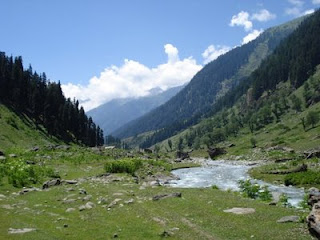 “
“ Global sea level is projected to rise between
Global sea level is projected to rise between  I’m a little over halfway through my brief stay here at the Wilson Center. This fellowship was made possible by CNN: They laid me off, along with my entire science, tech, and environment news team, in December.
I’m a little over halfway through my brief stay here at the Wilson Center. This fellowship was made possible by CNN: They laid me off, along with my entire science, tech, and environment news team, in December.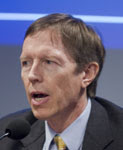 “The whole world is aging, and the developed countries are leading the way,” said Neil Howe of the Center for Strategic and International Studies (CSIS) at a January 27, 2009,
“The whole world is aging, and the developed countries are leading the way,” said Neil Howe of the Center for Strategic and International Studies (CSIS) at a January 27, 2009, 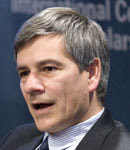 Jackson explained that the developing world is in the midst of the “demographic transition”—the drops in mortality and fertility that generally accompany economic and social development. Since 1970, the developing world’s overall fertility rate has declined from 5.1 to 2.9 children per woman, and its overall population growth rate has dropped from 2.2 percent to 1.3 percent per year, according to Jackson. Additionally, the median age has risen from 20 to 26 years old, “a cause for hope and optimism about the future,” Jackson argued, as countries with more balanced population age structures tend to be
Jackson explained that the developing world is in the midst of the “demographic transition”—the drops in mortality and fertility that generally accompany economic and social development. Since 1970, the developing world’s overall fertility rate has declined from 5.1 to 2.9 children per woman, and its overall population growth rate has dropped from 2.2 percent to 1.3 percent per year, according to Jackson. Additionally, the median age has risen from 20 to 26 years old, “a cause for hope and optimism about the future,” Jackson argued, as countries with more balanced population age structures tend to be 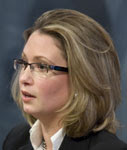 Sciubba praised the report’s comprehensive, policy-friendly approach to demography, but urged the authors to remain true to the nuances of their topic, even in their conclusions and recommendations. “Policymakers like to know what we don’t know and what we do know. And with population aging and national security, often there’s a lot more of what we don’t know than what we do know,” she said. “Going into the future, we need more of an emphasis on places where policymakers can make a difference,” said Sciubba. “Opportunities matter just as much as challenges.”
Sciubba praised the report’s comprehensive, policy-friendly approach to demography, but urged the authors to remain true to the nuances of their topic, even in their conclusions and recommendations. “Policymakers like to know what we don’t know and what we do know. And with population aging and national security, often there’s a lot more of what we don’t know than what we do know,” she said. “Going into the future, we need more of an emphasis on places where policymakers can make a difference,” said Sciubba. “Opportunities matter just as much as challenges.”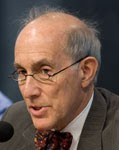 “There’s such a fundamental misunderstanding that most people have about the environment—that it exists outside of us,” said Harvard Medical School’s Eric Chivian at the January 14, 2009, launch of
“There’s such a fundamental misunderstanding that most people have about the environment—that it exists outside of us,” said Harvard Medical School’s Eric Chivian at the January 14, 2009, launch of  The city of Rio de Janeiro’s plan to erect a
The city of Rio de Janeiro’s plan to erect a 

